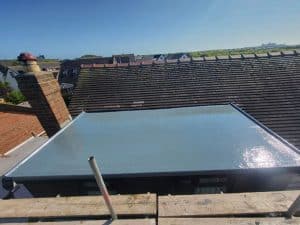FELT ROOFING VS FIBREGLASS (GRP) ROOFING: DECIDING ON THE BEST OPTION
Are you tired of sifting through endless online articles, trying to decide between felt roofing and fibreglass (GRP) roofing for your next roofing project? With so much conflicting information available, it can be difficult to know who to trust. But worry not, as we bring you over 20 years of on-the-job experience to help you make an informed decision.
We understand the importance of choosing the right roofing material for your home or business, and we are here to provide you with the truth. In this article, we will take a deep dive into the pros and cons of both felt roofing and fibreglass (GRP) roofing. From cost and durability to energy efficiency and ease of installation, we will cover it all.
So whether you’re a homeowner, business owner, or contractor, get ready for an interesting read as we unravel the truth behind felt roofing and fibreglass (GRP) roofing. Make sure to stick around till the end and you’ll be able to make the best decision for your roofing needs.
The Great Debate: Felt Roofing vs Fibreglass (GRP) Roofing
Introduction
When it comes to roofing, there are countless options to choose from. But when it comes to felt roofing and fibreglass (GRP) roofing, the debate rages on. Both materials have their pros and cons, making it difficult to decide which one is the best choice for your next roofing project.
With over 20 years of on-the-job experience, we understand the importance of choosing the right roofing material for your home or business. That’s why we’ve put together this article to help you make an informed decision. We’ll take a deep dive into the pros and cons of both felt roofing and fibreglass (GRP) roofing, so you can finally make a choice that’s right for you.
What You’ll Learn
- An overview of felt roofing and fibreglass (GRP) roofing
- The benefits and drawbacks of both materials
- A comparison of felt roofing and fibreglass (GRP) roofing
- Factors to consider when choosing between felt roofing and fibreglass (GRP) roofing
- A final recommendation on which type of roofing may be the best choice for different situations
So, whether you’re a homeowner, business owner, or contractor, get ready for an interesting read as we unravel the truth behind felt roofing and fibreglass (GRP) roofing. Stick around till the end and you’ll be able to make the best decision for your roofing needs.
Overview of Felt Roofing
Felt roofing is a type of roofing material that is made from a combination of organic and inorganic materials, such as asphalt, tar, and fibers. The material is then coated with a layer of asphalt or tar to make it waterproof. Felt roofing is commonly used on flat or low-sloped roofs, such as on commercial buildings or homes with flat roofs.
Benefits of Felt Roofing
- Cost-effective: Felt roofing is one of the most affordable roofing options on the market. It’s a great choice for those on a tight budget.
- Easy to install: Felt roofing is relatively easy to install, making it a great option for DIYers or those who want to save on labor costs.
Drawbacks of Felt Roofing
- Durability: Felt roofing is not as durable as other roofing options. It can easily be punctured by sharp objects and may not hold up as well in extreme weather conditions.
- Energy efficiency: Felt roofing does not have the same level of energy efficiency as other roofing options, which means it may not be the best choice for those looking to reduce their energy costs.
Conclusion
Felt roofing is a great option for those on a tight budget, or for those who want to do the installation themselves. However, it may not be the best choice for those who are looking for a more durable or energy-efficient roof. In the next section, we’ll take a look at fibreglass (GRP) roofing and compare it to felt roofing.
Overview of Fibreglass (GRP) Roofing
Fibreglass (GRP) roofing is a type of roofing material that is made from a combination of fiberglass and resin. The material is then reinforced with a layer of fiberglass matting to make it strong and durable. Fibreglass (GRP) roofing is commonly used on flat or low-sloped roofs, such as on commercial buildings or homes with flat roofs.
Benefits of Fibreglass (GRP) Roofing
- Durability: Fibreglass (GRP) roofing is extremely durable and can withstand extreme weather conditions, making it a great choice for those who want a long-lasting roof.
- Energy efficiency: Fibreglass (GRP) roofing has excellent energy efficiency, which means it can help reduce energy costs and keep your home or business cool during hot weather.
Drawbacks of Fibreglass (GRP) Roofing
- Cost: Fibreglass (GRP) roofing can be more expensive than other roofing options, making it less accessible for those on a tight budget.
- Installation: Fibreglass (GRP) roofing can be more challenging to install, which means it may require professional installation.
Conclusion
Fibreglass (GRP) roofing is a great option for those who want a long-lasting and energy-efficient roof. However, it can be more expensive and difficult to install, which means it may not be the best choice for those on a tight budget or those who want to do the installation themselves. In the next section, we’ll take a look at the comparison between felt roofing and fibreglass (GRP) roofing, so you can make the best decision for your roofing needs.
Comparison of Felt Roofing and Fibreglass (GRP) Roofing
When it comes to choosing a roofing material, there are many options available. Two popular choices are felt roofing and fibreglass (GRP) roofing. Both have their own unique benefits and drawbacks, so it’s important to understand the differences between the two before making a decision.
Durability and Longevity
Felt roofing is known for its durability and longevity, and can last for up to 20 years with proper maintenance. Fibreglass (GRP) roofing, on the other hand, is even more durable and can last for 30 years or more.
Weather Resistance
Both felt roofing and fibreglass (GRP) roofing are weather-resistant, but fibreglass (GRP) roofing is considered to be more resistant to extreme temperatures and harsh weather conditions.
Cost
When it comes to cost, felt roofing is generally considered to be more affordable than fibreglass (GRP) roofing.
Installation
Felt roofing is relatively easy to install and can be done by DIY enthusiasts or professionals with limited experience. Fibreglass (GRP) roofing, on the other hand, may be more difficult to install and require specialized knowledge and equipment.
Conclusion
Both felt roofing and fibreglass (GRP) roofing are great options for roofing, but the best choice will depend on your specific needs and budget. If you’re looking for a durable and long-lasting roof, fibreglass (GRP) roofing may be the best choice. But if you’re looking for an affordable option, felt roofing may be the way to go.
Overall Conclusion
In this article, we have discussed the pros and cons of felt roofing and fibreglass (GRP) roofing. We have compared the durability and longevity, weather resistance, cost, and ease of installation of both types of roofing.
Based on our 20 years of on-the-job experience, we have concluded that both felt roofing and fibreglass (GRP) roofing are great options for roofing, but the best choice will depend on your specific needs and budget. If you’re looking for a durable and long-lasting roof, fibreglass (GRP) roofing may be the best choice. But if you’re looking for an affordable option, felt roofing may be the way to go.
However, it’s important to note that every roofing project is unique, and the decision should be made after consulting with a professional roofing contractor. A professional roofing contractor will be able to assess your specific needs and provide you with guidance on which type of roofing may be the best choice for your situation.
In conclusion, we hope that this article has provided you with a better understanding of the differences between felt roofing and fibreglass (GRP) roofing, and has helped you make an informed decision. Remember to always consult with a professional roofing contractor before making any final decision
Overview of Fibreglass (GRP) Roofing
Fibreglass (GRP) roofing is a type of roofing material that is made from a combination of fiberglass and resin. The material is then reinforced with a layer of fiberglass matting to make it strong and durable. Fibreglass (GRP) roofing is commonly used on flat or low-sloped roofs, such as on commercial buildings or homes with flat roofs.
Benefits of Fibreglass (GRP) Roofing
- Durability: Fibreglass (GRP) roofing is extremely durable and can withstand extreme weather conditions, making it a great choice for those who want a long-lasting roof.
- Energy efficiency: Fibreglass (GRP) roofing has excellent energy efficiency, which means it can help reduce energy costs and keep your home or business cool during hot weather.
Drawbacks of Fibreglass (GRP) Roofing
- Cost: Fibreglass (GRP) roofing can be more expensive than other roofing options, making it less accessible for those on a tight budget.
- Installation: Fibreglass (GRP) roofing can be more challenging to install, which means it may require professional installation.
Conclusion
Fibreglass (GRP) roofing is a great option for those who want a long-lasting and energy-efficient roof. However, it can be more expensive and difficult to install, which means it may not be the best choice for those on a tight budget or those who want to do the installation themselves. In the next section, we’ll take a look at the comparison between felt roofing and fibreglass (GRP) roofing, so you can make the best decision for your roofing needs.
Comparison of Felt Roofing and Fibreglass (GRP) Roofing
When it comes to choosing a roofing material, there are many options available. Two popular choices are felt roofing and fibreglass (GRP) roofing. Both have their own unique benefits and drawbacks, so it’s important to understand the differences between the two before making a decision.
Durability and Longevity
Felt roofing is known for its durability and longevity, and can last for up to 20 years with proper maintenance. Fibreglass (GRP) roofing, on the other hand, is even more durable and can last for 30 years or more.
Weather Resistance
Both felt roofing and fibreglass (GRP) roofing are weather-resistant, but fibreglass (GRP) roofing is considered to be more resistant to extreme temperatures and harsh weather conditions.
Cost
When it comes to cost, felt roofing is generally considered to be more affordable than fibreglass (GRP) roofing.
Installation
Felt roofing is relatively easy to install and can be done by DIY enthusiasts or professionals with limited experience. Fibreglass (GRP) roofing, on the other hand, may be more difficult to install and require specialized knowledge and equipment.
Conclusion
Both felt roofing and fibreglass (GRP) roofing are great options for roofing, but the best choice will depend on your specific needs and budget. If you’re looking for a durable and long-lasting roof, fibreglass (GRP) roofing may be the best choice. But if you’re looking for an affordable option, felt roofing may be the way to go.
Overall Conclusion
In this article, we have discussed the pros and cons of felt roofing and fibreglass (GRP) roofing. We have compared the durability and longevity, weather resistance, cost, and ease of installation of both types of roofing.
Based on our 20 years of on-the-job experience, we have concluded that both felt roofing and fibreglass (GRP) roofing are great options for roofing, but the best choice will depend on your specific needs and budget. If you’re looking for a durable and long-lasting roof, fibreglass (GRP) roofing may be the best choice. But if you’re looking for an affordable option, felt roofing may be the way to go.
However, it’s important to note that every roofing project is unique, and the decision should be made after consulting with a professional roofing contractor. A professional roofing contractor will be able to assess your specific needs and provide you with guidance on which type of roofing may be the best choice for your situation.
In conclusion, we hope that this article has provided you with a better understanding of the differences between felt roofing and fibreglass (GRP) roofing, and has helped you make an informed decision. Remember to always consult with a professional roofing contractor before making any final decisions



